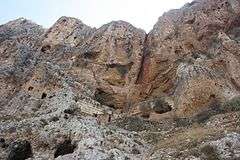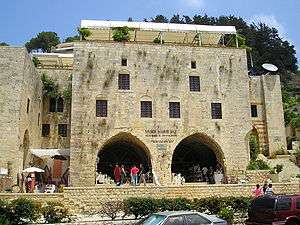Fakhr-al-Din II
| Fakhr-al-Din ibn Maan II | |
|---|---|
|
Fakhr-Al-Din II | |
| Born |
August 6, 1572 Baakleen, Mount Lebanon Emirate (Ottoman Empire) |
| Died |
April 13, 1635 Istanbul, Ottoman Empire |
| Home town | Baakleen |
| Title | The Big, Sultan of the Lands, Prince of Lebanon |
| Religion | Druze |
| Parent(s) | Korkmaz ibn-Maan |
| Relatives | Fakhreddine ibn-Maan I (grandfather) |

Emir Fakhr-al-Din ibn Maan (August 6, 1572 – April 13, 1635) (Arabic: الامير فخر الدين بن معن), also transliterated Fakhreddine, was a Druze Ma'ani prince and an early leader of the Emirate of Chouf, a self-governed area under the Ottoman Empire between the 17th and 19th centuries. Son of Prince Qorqmaz ibn Maan (Arabic: الامير قرقماز بن معن) and Sit Nasab (Arabic: الست نسب) of the Tanukhi family, he was given the title "Emir" or Prince in Arabic because the Maan family was pre-eminent in the Shouf and, periodically, a larger area. He is often referred to as "Fakhr ad-Din II" because of his grandfather Fakhr ad-Din I.[1] He and members of his family were from time to time appointed Sanjakbeyi or governor/tax-farmer of districts (Sanjaks) like Sidon or Beirut. His period was characterized by economic and cultural prosperity, and he had fought other Lebanese families to unite the people of Lebanon and seek independence from the Ottoman Empire. He is therefore considered by some to be the first "Man of Lebanon" to seek the sovereignty of modern-day Lebanon. Others consider this to be anachronistic as his aims were more dynastic than national. However, the Ottomans eventually tired of this troublesome vassal. Sultan Murad IV had him executed with one or two of his sons on April 13, 1635.
Born in Baakline to a Druze family, he was according to some accounts raised in the Lebanese village of Abey. There are conflicting versions of his early life, but it is certain that his father died when he was 13. One of the better accounts of the Maans in general and Fakhr ad-Din in particular is by Abdul-Rahim Abu-Husayn.[2]
In 1608 Fakhr-al-Din forged an alliance with the Italian Grand Duchy of Tuscany.[3] The alliance contained both a public economic section and a secret military one.
Fakhr-al-Din's ambitions, popularity and unauthorized foreign contacts alarmed the Ottomans who authorized Hafiz Ahmed Pasha, Muhafiz of Damascus, to mount an attack on Lebanon in 1613 in order to reduce Fakhr-al-Din's growing power. Professor Abu-Husayn has made the Ottoman archives relevant to the emir's career available.[4]
Faced with Hafiz's army of 50,000 men, Fakhr-al-Din chose exile in Tuscany, leaving affairs in the hands of his brother Emir Yunis and his son Emir Ali Beg. They succeeded in maintaining most of the forts such as Banias (Subayba) and Niha which were a mainstay of Fakhr ad-Din's power. Before leaving, Fakhr ad-Din paid his standing army of soqbans (mercenaries) two years wages in order to secure their loyalty.
Hosted in Tuscany by the Medici Family, Fakhr-al-Din was welcomed by the grand duke Cosimo II, who was his host and sponsor for the two years he spent at the court of the Medici. He spent a further three years as guest of the Spanish Viceroy of Sicily and then Naples, the Duke Osuna. Fakhr-al-Din had wished to enlist Tuscan or other European assistance in a "Crusade" to free his homeland from Ottoman domination,[5] but was met with a refusal as Tuscany was unable to afford such an expedition. The prince eventually gave up the idea, realizing that Europe was more interested in trade with the Ottomans than in taking back the Holy Land. His stay nevertheless allowed him to witness Europe's cultural revival in the 17th century, and bring back some Renaissance ideas and architectural features.[6]
By 1618, political changes in the Ottoman sultanate had resulted in the removal of many of Fakhr-al-Din's enemies from power, allowing Fahkr-al-Din's return to Lebanon, whereupon he was able quickly to reunite all the lands of Lebanon beyond the boundaries of its mountains; and having revenge from Emir Yusuf Pasha ibn Siyfa, attacking his stronghold in Akkar, destroying his palaces and taking control of his lands, and regaining the territories he had to give up in 1613 in Sidon, Tripoli, Bekaa among others. Under his rule, printing presses were introduced and Jesuit priests and Catholic nuns encouraged to open schools throughout the land.

In 1623, the prince angered the Ottomans by refusing to allow an army on its way back from the Persian front to winter in the Bekaa. This (and instigation by the powerful Janissariy garrison in Damascus) led Mustafa Pasha, Governor of Damascus, to launch an attack against him, resulting in the battle at Majdel Anjar where Fakhr-al-Din's forces although outnumbered managed to capture the Pasha and secure the Lebanese prince and his allies a much needed military victory. The best source (in Arabic) for Fakhr ad-Din's career up to this point is a memoir signed by al-Khalidi as-Safadi, who was not with the Emir in Europe but had access to someone who was, possibly Fakhr ad-Din himself.[7]
However, as time passed, the Ottomans grew increasingly uncomfortable with the prince's increasing powers and extended relations with Europe. In 1632, Kuchuk Ahmed Pasha was named Muhafiz of Damascus, being a rival of Fakhr-al-Din and a friend of Sultan Murad IV, who ordered Kuchuk Ahmed Pasha and the sultanate's navy to attack Lebanon and depose Fakhr-al-Din.

This time, the prince had decided to remain in Lebanon and resist the offensive, but the death of his son Emir Ali Beik in Wadi el-Taym was the beginning of his defeat. He later took refuge in Niha's grotto, closely followed by Kuchuk Ahmed Pasha. He surrendered to the Ottoman general Jaafar Pasha, whom he knew well, under circumstances that are not clear.[8]
Fakhr-al-Din was taken to Istanbul and kept in the Yedikule (Seven Towers) prison for two years. He was then summoned before the sultan. Fakhr-al-Din, and one or two of his sons, were accused of treason and executed there on 13 April 1635. There are unsubstantiated rumors that the younger of the two boys was spared and raised in the harem, later becoming Ottoman ambassador to India.
After his death, his nephew Ahmed Maan ruled the Shouf heartland of Fakhr ad-Din's former domains. On Ahmed's death in 1697, the Shihab family succeeded the Maans as "Emirs of Mount Lebanon".[2]
Rumors have it that Fakhr-al-Din had secretly adopted the Christian faith. Those rumors, first reported in the Memoirs of Fakhr ad-Din's personal physician, the Franciscan Etienne Roger, are not corroborated by any other independent source.[9] In addition, during his time in Italy, many priests tried to convert him to Christianity but he refused to change his religion and said: "We came here to talk politics and not to change our religion". Thus historians agree that Fakhreddine lived and died as a Druze.
References
- ↑ Salibi, Kamal (July 1973). "The Secret of the House of Ma'n". International Journal of Middle East Studies. 4 (3): 272–287. doi:10.1017/S0020743800031469. JSTOR 162160.
- 1 2 Abdul Rahim Abu Husayn (1985). Provincial Leaderships in Syria, 1575-1650. American University of Beirut.
- ↑ Carali, P. Paolo (Qar’ali, Father Bulus) (1936). Fakhr ad-Dīn II, principe del Libano e la Corte di Toscana: 1605 - 1635. Reale Accademia d'Italia.
- ↑ Abdul Rahim Abu Husayn (2004). The View from Istanbul: Ottoman Lebanon and the Druze Emirate. I.B.Tauris. ISBN 978-1-86064-856-4.
- ↑ Charles Winslow (4 October 2003). Lebanon: War and Politics in a Fragmented Society. Routledge. pp. 16–17. ISBN 978-0-203-21739-9.
- ↑ The best European source for information about the Emir's stay there is the works of Palo Carali (Boulos Car'ali): Carali, P. Paolo (Qar’ali, Father Bulus): Fakhr ad-Din II Principe del Libano e la Corte di Toscana 1605-1635 (Rome, Reale Accademia d’Italia, 1936) (2 Vol.); Fakhr ad-din al-Ma’ni ath-thani, hakim lubnan (Jdeidet al-matn, Dar lahd khater, 1992); "Soggiorno de Fakhr ad-din II al-Ma’ni in Toscana, Sicilia e Napoli e la sua visita a Malta (1613-1618)", in Annali del Istituto Superiore Orientale di Napoli, Vol VIII no. 4 (September, 1936) pp. 15-60
- ↑ أحمد بن محمد الخالدي الصفدي (1969). لبنان في عهد الأمير فخر الدين المعني الثاني (in Arabic). Beirut: منشورات الجامعة اللبنانية.
- ↑ Philip Khuri Hitti (1967). Lebanon in history: from the earliest times to the present. Macmillan.
- ↑ Eugène Roger (1664). La terre sainte, ou description topographique tres-particuliere des saints Lieux, & de la terre de Promission. Auec vn traitté de quatorze Nations de differente religion qui l'habitent, leurs moeurs, croyance, ceremonies & police ... L'histoire de la vie. chez Antoine Bertier.
Further reading
- A. Hourani, New Documents on the History of Mount Lebanon and Arabistan in the 10th and 11th Centuries H. pp. 918–942 (Beirut: 2010)
- T. J. Gorton, Renaissance Emir: a Druze Warlord at the Court of the Medici (London: Quartet Books, 2013)
- R. Cuffaro, "Fakhr ad-Din II alla corte dei Medici (1613-1615). Collezionismo, architettura e ars topiaria tra Firenze e Beirut", in: Marburger Jahrbuch für Kunstwissenschaft, 2010
-2.png)
